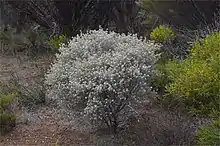| Spyridium bifidum | |
|---|---|
 | |
| Subspecies bifidum | |
| Scientific classification | |
| Kingdom: | Plantae |
| Clade: | Tracheophytes |
| Clade: | Angiosperms |
| Clade: | Eudicots |
| Clade: | Rosids |
| Order: | Rosales |
| Family: | Rhamnaceae |
| Genus: | Spyridium |
| Species: | S. bifidum |
| Binomial name | |
| Spyridium bifidum | |

Spyridium bifidum, commonly known as forked spyridium, is a species of flowering plant in the family Rhamnaceae and is endemic to South Australia. It is an erect shrub with densely softly-hairy young stems, wedge-shaped to linear leaves sometimes with a two-lobed tip, and densely woolly heads of white-velvety flowers.
Description
Spyridium bifidum is an erect shrub that typically grows to a height of up to 2 m (6 ft 7 in), its young stems densely covered with simple and star-shaped hairs. The leaves are wedge-shaped to linear, 3.2–13 mm (0.13–0.51 in) long and 1–5 mm (0.039–0.197 in) wide on a petiole 0.7–1.5 mm (0.028–0.059 in) long. The edges of the leaves are rolled under, the tip is sometimes forked with two lobes, both surfaces are covered with soft, star-shaped hairs, and there are triangular to narrowly egg-shaped stipules at the base. The more or less spherical heads of "flowers" are 8–12 mm (0.31–0.47 in) wide, the individual flowers more or less sessile and silky-hairy. Each head is surrounded by 4 or 5 velvety, white leaves, each more or less divided into two. The fruit is a light brown capsule 2.2–2.5 mm (0.087–0.098 in) long.[2][3]
Taxonomy
This species was first formally described in 1855 by Ferdinand von Mueller who gave it the name Trymalium bifidum in his Definitions of rare or hitherto undescribed Australian plants.[4][5] In 1863, George Bentham changed the name to Spyridium bifidum in Flora Australiensis.[6] The specific epithet (bifidum) refers to the forked leaves of this species.[3]
In 2012, Jürgen Kellermann and William Robert Barker described two subspecies of Spyridium bifidum in the journal Muelleria and the names are accepted by the Australian Plant Census:
Distribution and habitat
Spyridium bifidum grows in mallee shrubland on the Marble Range and on the hills to the east of Edillilie, the two subspecies separated by only 5 or 6 km (3.1 or 3.7 mi). Subspecies bifidum is restricted to the Marble Range, and flowers from June to September, subspecies wanillae is mostly found around Wanilla on the Eyre Peninsula, and flowers in July.[2]
References
- ↑ "Spyridium bifidum". Australian Plant Census. Retrieved 27 June 2022.
- 1 2 3 4 Kellerman, Jürgen; Barker, William R. (2012). "Revision of the Spyridium bifidum - S. halmaturinum complex (Rhamaceae: Pomaderreae) from South Australia and Victoria". Muelleria. 30 (1): 46–52.
- 1 2 "Spyridium bifidum". State Herbarium of South Australia. Retrieved 27 June 2022.
- ↑ "Trimalium trifidum". Australian Plant Name Index. Retrieved 27 June 2022.
- ↑ von Mueller, Ferdinand (1855). Definitions of rare or hitherto undescribed Australian plants. Melbourne: Goodhugh & Trembath. p. 42. Retrieved 27 June 2022.
- ↑ "Spyridium trifidum". Australian Plant Name Index. Retrieved 27 June 2022.
- ↑ "Spyridium bifidum subsp. bifidum". Australian Plant Census. Retrieved 27 June 2022.
- ↑ "Spyridium bifidum subsp. wanillae". Australian Plant Census. Retrieved 27 June 2022.